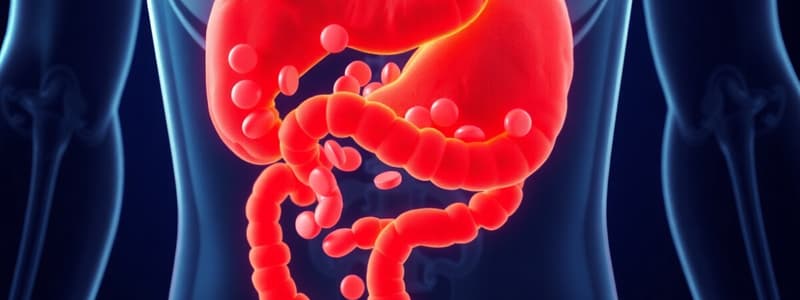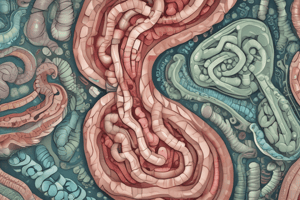Podcast
Questions and Answers
¿Cuál de las siguientes afirmaciones sobre las lesiones mucosas por estrés es correcta?
¿Cuál de las siguientes afirmaciones sobre las lesiones mucosas por estrés es correcta?
¿Qué tipo de prostaglandinas son inhibidas por los AINEs clásicos como el ibuprofeno?
¿Qué tipo de prostaglandinas son inhibidas por los AINEs clásicos como el ibuprofeno?
¿Cuál es el mito común relacionado con la administración de AINEs?
¿Cuál es el mito común relacionado con la administración de AINEs?
¿Cuál es uno de los factores de riesgo más importantes para desarrollar complicaciones por AINEs?
¿Cuál es uno de los factores de riesgo más importantes para desarrollar complicaciones por AINEs?
Signup and view all the answers
¿Qué efecto sistémico es más importante en el daño gastrointestinal causado por AINEs?
¿Qué efecto sistémico es más importante en el daño gastrointestinal causado por AINEs?
Signup and view all the answers
¿Cuál es la función principal de las contracciones primarias en el esófago?
¿Cuál es la función principal de las contracciones primarias en el esófago?
Signup and view all the answers
¿Qué tipo de músculo se encuentra en la parte superior del esófago?
¿Qué tipo de músculo se encuentra en la parte superior del esófago?
Signup and view all the answers
¿Cuál de las siguientes afirmaciones sobre el esfínter esofágico inferior (EEI) es incorrecta?
¿Cuál de las siguientes afirmaciones sobre el esfínter esofágico inferior (EEI) es incorrecta?
Signup and view all the answers
La mucosa del esófago está formada por epitelio escamoso y ¿qué otra estructura?
La mucosa del esófago está formada por epitelio escamoso y ¿qué otra estructura?
Signup and view all the answers
¿Qué estructura ayuda a evitar el reflujo gastroesofágico junto con el esfínter esofágico inferior?
¿Qué estructura ayuda a evitar el reflujo gastroesofágico junto con el esfínter esofágico inferior?
Signup and view all the answers
Las contracciones secundarias en el esófago tienen como objetivo principal:
Las contracciones secundarias en el esófago tienen como objetivo principal:
Signup and view all the answers
¿Cuál de las siguientes capas del esófago contiene los vasos sanguíneos y fibras nerviosas?
¿Cuál de las siguientes capas del esófago contiene los vasos sanguíneos y fibras nerviosas?
Signup and view all the answers
¿Cuál de las siguientes afirmaciones sobre las contracciones terciarias es correcta?
¿Cuál de las siguientes afirmaciones sobre las contracciones terciarias es correcta?
Signup and view all the answers
¿Cuál es la función principal del esfínter esofágico superior (EES)?
¿Cuál es la función principal del esfínter esofágico superior (EES)?
Signup and view all the answers
¿Qué mecanismo de defensa no contribuye a proteger el esófago contra infecciones?
¿Qué mecanismo de defensa no contribuye a proteger el esófago contra infecciones?
Signup and view all the answers
¿Cuál de los siguientes neurotransmisores es considerado excitador en el sistema neuroendocrino intestinal?
¿Cuál de los siguientes neurotransmisores es considerado excitador en el sistema neuroendocrino intestinal?
Signup and view all the answers
¿Qué tipo de pacientes es más susceptible a desarrollar esofagitis infecciosa?
¿Qué tipo de pacientes es más susceptible a desarrollar esofagitis infecciosa?
Signup and view all the answers
¿Cuál es la causa más común de esofagitis infecciosa?
¿Cuál es la causa más común de esofagitis infecciosa?
Signup and view all the answers
¿Qué efecto tiene el uso incontrolado de antibióticos en la flora intestinal?
¿Qué efecto tiene el uso incontrolado de antibióticos en la flora intestinal?
Signup and view all the answers
¿Qué condición del epitelio puede facilitar la aparición de esofagitis en pacientes inmunocompetentes?
¿Qué condición del epitelio puede facilitar la aparición de esofagitis en pacientes inmunocompetentes?
Signup and view all the answers
¿Qué neurotransmisores inhiben la contracción del esfínter esofágico superior?
¿Qué neurotransmisores inhiben la contracción del esfínter esofágico superior?
Signup and view all the answers
¿Cuál de las siguientes condiciones no es una causa neurológica de disfagia?
¿Cuál de las siguientes condiciones no es una causa neurológica de disfagia?
Signup and view all the answers
La manometría esofágica ayuda a determinar:
La manometría esofágica ayuda a determinar:
Signup and view all the answers
La acalasia se caracteriza por la incapacidad del esófago para:
La acalasia se caracteriza por la incapacidad del esófago para:
Signup and view all the answers
¿Qué mecanismo se ve reducido en la acalasia que contribuye a la retención de alimentos?
¿Qué mecanismo se ve reducido en la acalasia que contribuye a la retención de alimentos?
Signup and view all the answers
¿Cuál es la incidencia de la acalasia en la población general?
¿Cuál es la incidencia de la acalasia en la población general?
Signup and view all the answers
La disfagia esofágica es comúnmente conocida como:
La disfagia esofágica es comúnmente conocida como:
Signup and view all the answers
Cuál de las siguientes afirmaciones sobre la etiología de la disfagia es correcta?
Cuál de las siguientes afirmaciones sobre la etiología de la disfagia es correcta?
Signup and view all the answers
¿Qué se debe descartar primero ante cualquier caso de disfagia?
¿Qué se debe descartar primero ante cualquier caso de disfagia?
Signup and view all the answers
¿Qué tipo de disfagia se presenta normalmente en pacientes con acalasia?
¿Qué tipo de disfagia se presenta normalmente en pacientes con acalasia?
Signup and view all the answers
La ansiedad que a menudo experimentan los pacientes con disfagia puede asociarse a:
La ansiedad que a menudo experimentan los pacientes con disfagia puede asociarse a:
Signup and view all the answers
¿Cuál de los siguientes síntomas no suele aparecer en el herpes simple?
¿Cuál de los siguientes síntomas no suele aparecer en el herpes simple?
Signup and view all the answers
¿Cuál es la característica de las úlceras que se observan en la endoscopia durante una infección por herpes simple?
¿Cuál es la característica de las úlceras que se observan en la endoscopia durante una infección por herpes simple?
Signup and view all the answers
¿Qué patógeno se espera encontrar en el fondo de las úlceras esofágicas en lugar del herpes simple?
¿Qué patógeno se espera encontrar en el fondo de las úlceras esofágicas en lugar del herpes simple?
Signup and view all the answers
En una infección por herpes simple, ¿dónde se deben tomar las biopsias para confirmar el diagnóstico?
En una infección por herpes simple, ¿dónde se deben tomar las biopsias para confirmar el diagnóstico?
Signup and view all the answers
¿Cuál de las siguientes afirmaciones es incorrecta acerca de la infección por herpes simple?
¿Cuál de las siguientes afirmaciones es incorrecta acerca de la infección por herpes simple?
Signup and view all the answers
¿Qué complicación puede ocurrir si la deglución está impedida por odinofagia intensa en una infección por herpes simple?
¿Qué complicación puede ocurrir si la deglución está impedida por odinofagia intensa en una infección por herpes simple?
Signup and view all the answers
¿Cuál de las siguientes pruebas serológicas es útil para detectar una primoinfección por virus del herpes simple?
¿Cuál de las siguientes pruebas serológicas es útil para detectar una primoinfección por virus del herpes simple?
Signup and view all the answers
¿Cuál es el tratamiento recomendado para pacientes inmunocomprometidos con infección por herpes simple?
¿Cuál es el tratamiento recomendado para pacientes inmunocomprometidos con infección por herpes simple?
Signup and view all the answers
¿Qué significan las células epiteliales multinucleadas con inclusiones virales observadas en una biopsia?
¿Qué significan las células epiteliales multinucleadas con inclusiones virales observadas en una biopsia?
Signup and view all the answers
¿Cuál es una característica distintiva de las úlceras por herpes simple comparadas con otros tipos de úlceras esofágicas?
¿Cuál es una característica distintiva de las úlceras por herpes simple comparadas con otros tipos de úlceras esofágicas?
Signup and view all the answers
Study Notes
General Gastric Study Notes
- Gastritis is the inflammation of the stomach lining.
- It is a broad term encompassing various types, categorized by cause, severity, and location.
- Diagnostic confirmation often requires a biopsy and histological examination.
Types of Gastritis
- Acute Gastritis: A sudden inflammation, often caused by factors like alcohol, infections, or medications. Symptoms are typically temporary and resolve with treatment or discontinuation of the offending agent.
- Chronic Gastritis: A long-term inflammation that can be caused by different factors, most commonly infection by Helicobacter pylori. The inflammation can lead to long-term complications like atrophy and increased cancer risk.
H. Pylori Gastritis
- Etiology: Infection by the bacterium Helicobacter pylori is the most common cause of chronic gastritis worldwide.
- Mechanism of Action: The bacteria produce urease, enabling it to survive the acidic environment, ultimately leading to inflammation and potential ulceration.
- Importance: H. pylori infection is a significant risk factor for gastric and duodenal ulcers and is an important consideration in chronic gastritis cases.
Gastritis Caused by NSAIDs
- Etiology: Nonsteroidal anti-inflammatory drugs (NSAIDs), such as ibuprofen and aspirin, can cause damage to the stomach lining through their effects on prostaglandin production. This can lead to inflammation and ulceration.
- Mechanism of Action: NSAIDs inhibit prostaglandins, a factor critical in protecting the stomach lining. The inhibition leads to decreased protection, increasing vulnerability to the acidic environment.
- Importance: NSAIDs are common medications, and their potential for causing gastritis is a significant concern, especially in people with a history of ulcers or individuals taking high doses over an extended period.
Atypical Causes of Gastritis
- Cause: Gastroparesis, Zollinger-Ellison syndrome, and conditions like Crohn's disease can also cause gastritis.
- Symptoms: Symptoms of these atypical causes often differ and may involve nausea, vomiting, and abdominal pain.
- Importance: Recognizing these atypical causes is clinically important as the treatment and management differ significantly.
Diagnosis of Gastritis
- Endoscopy: A crucial diagnostic tool that allows visualization of the stomach lining for abnormalities like redness, swelling, ulcerations, or other inflammation. Biopsies are often taken during endoscopy for examination under a microscope.
- Histological examination: Microscopic analysis of tissue samples from biopsies is essential for definitive diagnosis identification of cell types, inflammatory markers, or bacterial presence.
- Additional tests: Blood tests, stool tests, and breath tests to detect or confirm the presence of H. Pylori.
Treatment of Gastritis
- Lifestyle modifications: Reducing alcohol consumption, and ceasing NSAID use are often initial recommendations.
- Medications (e.g., antacids, proton pump inhibitors - PPIs-, H2 receptor antagonists), are often needed for symptom relief, healing, and prevention of further mucosal damage.
- The type of treatment depends on the underlying cause of the gastritis and may include antibiotics for bacterial infections, or other treatments for atypical causes.
Complications of Gastritis
- Ulcers: Gastritis can lead to ulcers, which are painful sores in the lining of the stomach or duodenum.
- Gastric atrophy: Chronic gastritis can cause atrophy (thinning) of the stomach, potentially diminishing the production of stomach acid and impacting nutrient absorption.
- Increased risk of gastric cancer: Long-term chronic gastritis can significantly increase the risk of developing gastric cancer, especially if an infection by H. pylori is found.
Studying That Suits You
Use AI to generate personalized quizzes and flashcards to suit your learning preferences.
Related Documents
Description
Este cuestionario evalúa tus conocimientos sobre las lesiones mucosas por estrés, el uso de AINEs y su impacto en el esófago. Abarca temas como las prostaglandinas, complicaciones y funciones musculares en el sistema gastrointestinal. Prepárate para verificar tu comprensión sobre estos importantes aspectos farmacológicos y anatómicos.




